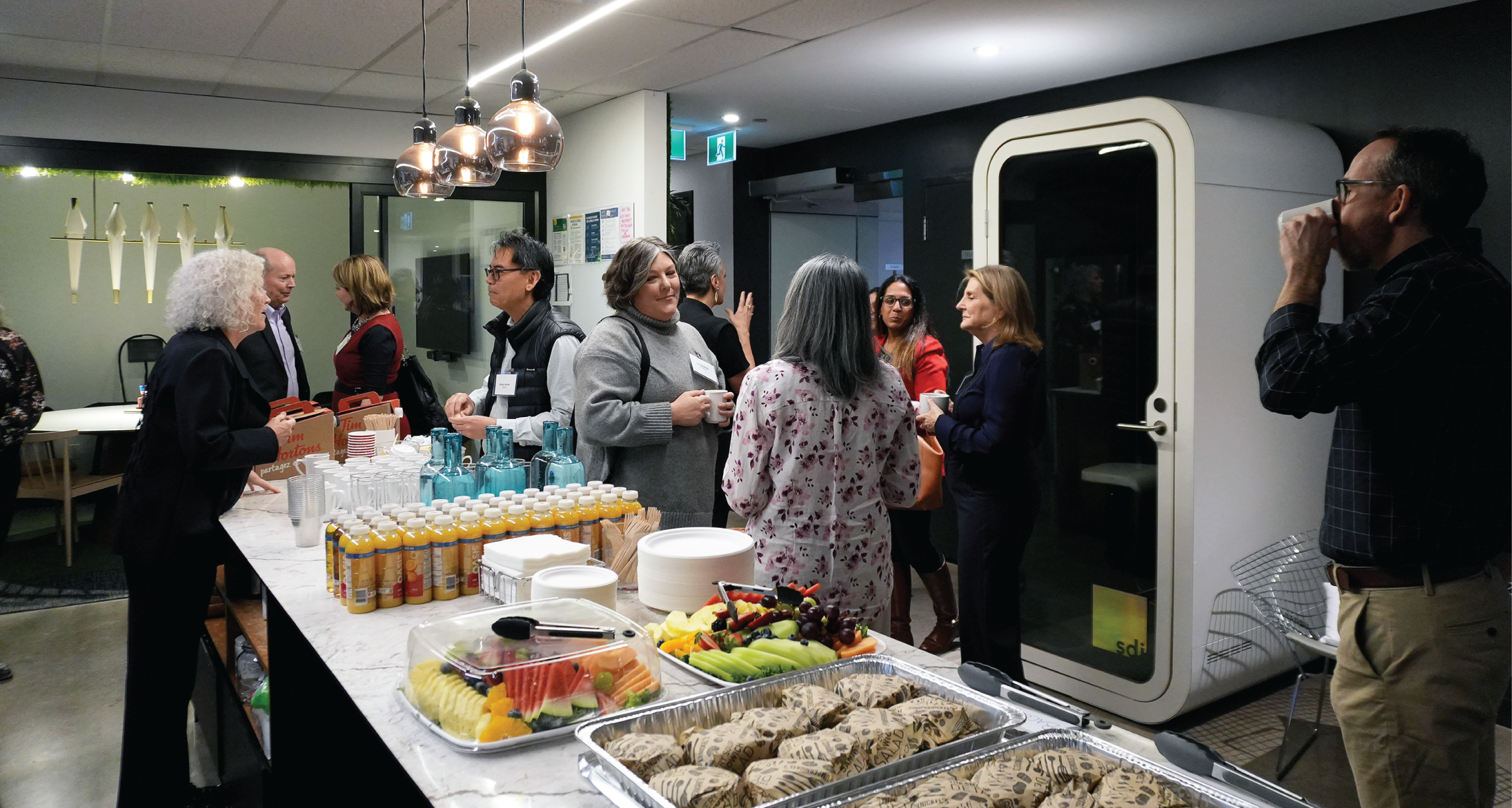If you walked into a fancy law office decades ago, you could understand the hierarchy of the firm simply by looking at each office. The square footage per person was directly associated with each person’s status and tenure at the firm. Partner suites were held in perimeter offices with beautiful vistas, junior partner offices were half that size and associates and support staff worked from cubicles stuffed in the center of the floor. In the 90’s, attorney suites would average nearly 800 square feet per person. In the mid-2000’s, their commercial office structures began to shift into a more balanced floor plate. While the square footage per person has since trended downward, many law firms hadn’t embraced newer space standards that organizations in other industries had been designing around for years. During the pandemic, legal teams adjusted to less in-person contact with their clients, working brutal hours in the comfort of their homes instead of brutal hours at their office. Technology teams scrambled to secure confidential transmissions through computers, cell phones and landlines that were no longer housed under one roof. And now, having seen the viability – dare we say, the thrive-ability – of a new hybrid workstyle, leaders of mixed generations are considering real estate plans that integrate the new reality of remote work with the form and function of their operation. In fact, they’re forging the way for others.

Several members of our organization who work with legal clients around the country have responded to questions surrounding the current state of this industry.
Where do law firms want to be?
Matt Harvey, a Principal in Cresa’s Boston office, circulates an annual benchmarking study which provides insight into Boston’s law firms. “Anecdotally, I haven’t come across a single firm that thinks they have it figured out. Lawyers are trained to follow precedent, and they tend to think about real estate the same way. That said, no two firms have the same culture. Some firms have different cultures within their firm. No one knows a firm’s culture better than the people within that firm, and any discussion about workplace policy changes should start within the walls of that firm because that’s where they’ll find the answers. They really need to go through the process of self-discovery and scenario modeling that’s specific to their firm.”
“In Denver, two large downtown law firms will leave older buildings and move to Denver’s newest high-rise tower. Both made significant decisions on downsizing and are implementing a hybrid, remote-work model,” says Bruce Johnson, Managing Principal, Denver. “In another shift, the market was surprised when two other firms – seen as conservative and traditional – decided to leave downtown and move to nearby RiNo, known for its industrial feel, contemporary art galleries and a hip concert venue. I would guess younger leaders have a strong influence in the direction of those firms, and RiNo is a great place to recruit young talent.”
Brandon Leitner, Senior Vice President, discussed this with one of his clients who works for a large Am Law 100 firm (American Lawyer’s 100 highest grossing law firms in the country), based in Boston. His client commented, “Law firms want to avoid stale neighborhood or business districts. As an example, when our lease was up several years ago, the thought of going into Boston’s financial district was so unappealing. We were happy to stay in the Seaport because it was a fresh, vibrant area that was still growing. I’d certainly say that access to public transportation and newer dining options (including food halls) are a big plus. Building or neighborhood amenities are a huge plus.”
Blake St. Onge, Managing Principal, sees the same in . “Depends on the type of firm, but many still believe that proximity to city centers is critical; proximity to clients, center of gravity for governments, amenities and places to conduct meetings and business."
“It depends on the firm size and the type of work they’re engaged in,” agrees Paul Skene, Managing Principal, Salt Lake City. “Litigators are still largely working from the office due to in-house depositions as an example, whereas intellectual property or professional contract firms are more flexible.”
In San Diego, Principal Chris Musgjerd says, “The ‘experiment’ worked and office space has become far less important for some/many. I know other law firms that will stay in office environments and working from home is not an option.”
What’s the post-Covid vibe inside law firms?
Hansell Roddenbery, a tenured principal in both Cresa’s Atlanta office and in understanding the pulse of these influential entities, has remained abreast of the everchanging trends throughout his professional affiliations and connecting with his legal clients on a regular basis. “Since the pandemic began, technology has allowed attorneys to continue performing legal services to their clients while away from the office. As with any industry, collaboration and team meetings are important, so having face-to-face conversations is still necessary to increase productivity.”
Leitner’s clients observes, “Most law firms have seemed to settle on something close to a ‘three days in the office’ requirement. While there are surely some partners at every firm who will insist that their teams be in the office more often than not (or even five days a week), I would say such mentality is currently the exception rather than the rule. Associates do not want to come into the office only to be on Zoom meetings all day. They want training, mentorship, team interaction or special events.”
“With regard to mentorship, it’s critical to have in-office time,” agrees St. Onge. “Much of the heads down/transaction style work can be performed at home, again, depending on the person and company culture or attorney function.”
“Some of the older partners who were most vocal about being in the office pre-Covid are now the ones who rarely come into the office. Some of these partners may be full remote until retirement,” says Johnson. “Older attorneys rely on their support staff more than younger ones, so there is the issue of where support staff should be – as many prefer to be in the office to most efficiently accommodate their team’s business needs.”
Musgjerd notices, “Some of my clients are simply not going back. Older, well-established, financially stable lawyers that have homes and family are less excited about leaving home. It’s a different mindset between them and lawyers fresh out of law school who might still be renting and do not have that financial or family support/environment. T&M did a nationwide poll and 95% of their lawyers never want to go back into an office.”
Will Scovill, a Senior Vice President in San Francisco comments, “Law firms during and post-Covid, have been doing incredibly well. The war on talent has only gotten worse since Covid. Therefore, any leverage to force associates to come into the office has vanished.”
What conversations should brokers be having with law firms?
“Law firms were consolidating long before the pandemic and are still trying to find the best innovative design solutions moving forward,” says Roddenbery. “No need to recreate the wheel. The key is to sit down with the current and future leaders of the law firm to find out what has been working well within their firm post-Covid. After generating the top priorities, you’ll be able to help them implement the right solutions for their particular law firm.”
“I would say that it really is going to be first dependent on the culture of the firm,” says Workplace Strategy Director, Gillian Baikie. “How much (if at all) do they want to incorporate flexible/distributed work as part of their real estate strategy, are they more traditional, or more progressive, are they trying to drive more collaboration among the firm or prioritize focused, heads-down work for the team members? They do, of course, want to know what everyone else is doing, but I would say that firm culture will ultimately drive the results so, ‘normal’ is very much a relative term.”
Leitner’s client believes they need, “Guidance on what landlords are offering to attract and maintain tenants -- anything from financial incentives to building services and amenities. Just as associates are being more selective of law firms, law firms will be more selective of space and locations.”
“The traditions and historic norms of a legal firm are the first questions regarding culture. Is there the hierarchal office condition (size and tenure) within the firm or do they want to adopt a more open concept? Does the firm want to promote a desk sharing concept, or a single desk per person concept?” asks Workplace Strategy senior architect, Marcus Hanlon.
Is there a current transition from an “older” mindset of large floorplates per person into a smaller footprint?
“Yes,” says Leitner’s client. “And this was a mindset that was already shaping pre-Covid. That being said, law firms are going to smarter or more equal footprints. You are starting to see the extravagant, corner partner office get smaller or disappear. With many firms looking at alternative staffing models for certain legal work, we are starting to see more shared space arrangements for non-associates/partners.”
“Yes,” says St. Onge. “There has been for the past decade, and Covid has assisted in the reality of implementing alternative work strategies for law firms. Smaller private offices, more collaborative, client facing spaces and conference rooms.”
“Younger leaders have a strong influence on the direction of law offices. They are motivated to situate their business in places that will recruit strong talent,” says Johnson.
Minneapolis’ Managing Principal Steve Dorgan says, “We are finding consensus that in-person and in-office meetings are necessary. Both with clients and co-worker teams. For culture and business to thrive, in-person collaboration must occur. That said, full-time workspaces are not entirely necessary. New generation workers don’t need the workspace designed for the law firms of the past. The future is more flexibility in the workspace with more options for collaboration when you are in the office.”


